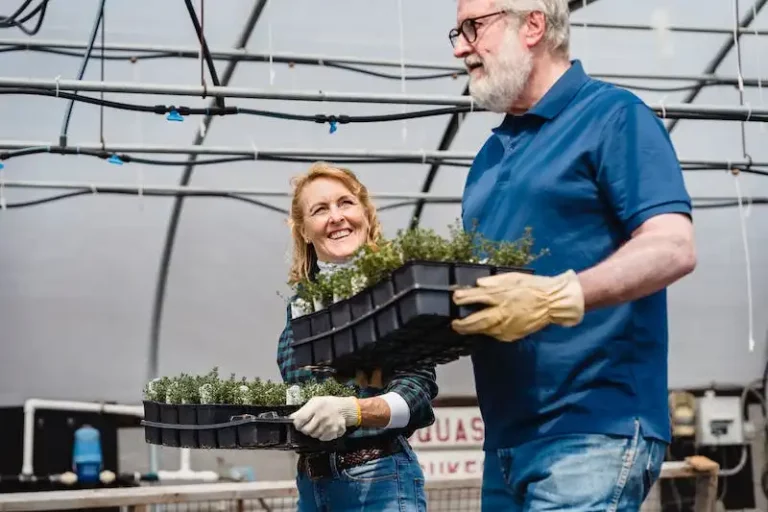Eryngiums, commonly known as sea hollies, are a perfect addition to any garden. These unique plants, with their spiky blue-grey foliage and stunning flower heads, will make a gardener’s heart skip a beat. Whether you’re a seasoned gardener or a beginner, growing eryngiums is a breeze. In this guide, we will answer some frequently asked questions about eryngiums and provide you with a step-by-step plan on how to grow and care for these beautiful plants.
Members of the Apiaceae family, eryngiums are herbaceous perennials that can be grown in a wide range of climates. Most eryngium species are native to coastal areas, so they are a good choice for gardeners living near the sea or in areas with similar conditions. These drought-tolerant plants will thrive in dry, sandy soil and do not require much water. However, they should be watered regularly during their first year to encourage strong root growth.
When it comes to planting eryngiums, the location is key. These plants prefer a full sun or lightly shaded spot in the garden with well-draining soil. Before planting, make sure to prepare the soil by removing any weeds and adding organic matter, such as compost or well-rotted manure. It’s also a good idea to incorporate a layer of mulch around the plants to help retain moisture and suppress weed growth.
Eryngiums are known for their branching stems and spikey flower heads, which can add a unique touch to any garden border or landscaping scheme. They also make a great addition to cut flower arrangements, providing an interesting texture and long-lasting beauty. If you want to ensure a good coverage in your garden, we recommend planting eryngiums in groups or clusters.
As for the care and maintenance of eryngiums, pruning is a key task. Deadheading the flower heads will not only remove spent blooms, but it will also encourage the plant to produce more flowers. It’s best to prune eryngiums in early spring or late winter, before the new growth starts. Simply cut the stems down to the ground, and new leaves will emerge from the base. If you want to remove any unwanted stems or foliage during the growing season, use clean and sharp pruning shears to avoid damaging the plant.
In conclusion, growing eryngiums in your garden can be a rewarding experience for any gardener. With their unique foliage, stunning flower heads, and low-maintenance requirements, eryngiums are a great choice for both beginner and experienced gardeners alike. Follow the steps outlined in this guide, and you’ll be enjoying the beauty of eryngiums in your garden in no time.
How to Plant Eryngium Roots
Planting eryngium roots is a perfect way to add these unique and spiny plants to your garden. Eryngiums, commonly known as sea holly or eryngo, belong to the thistle-like family and are popular perennials grown by many gardeners. If you are a fan of their grey foliage and spiky flower heads, here is a guide on how to plant eryngium roots.
Choosing the Right Location:
Eryngiums are generally grown in full sun and require well-draining soil. They are often found in coastal areas, so a location with a similar climate is ideal. In the USA, eryngiums are frequently grown in the states of California, Oregon, and Washington. They can also be grown in other regions if the conditions are suitable.
Planting Flats or Cuttings:
There are typically two ways to plant eryngiums: by flats or by cuttings. Flats refer to trays that contain multiple plants, which can be bought from a nursery or online. If you prefer a specific variety, you can grow eryngiums from cuttings. Simply cut a stem with some foliage and plant it in moist soil.
Caring for Eryngiums:
Eryngiums are generally low-maintenance plants, but they still require some care. They don’t need regular watering and can tolerate poor soil conditions. However, it’s important to mulch around the plants to help retain moisture and suppress weeds. Pruning can be done once the flowering season is over to maintain the plant’s shape.
Dealing with Pests and Diseases:
Eryngiums are generally not prone to pests and diseases. However, they can be susceptible to fungal infections if the soil is consistently wet. To prevent this, make sure the soil is well-draining and avoid overwatering. If you notice any signs of diseases or pests, consult a gardening guide or seek advice from a local horticulturist.
Summary:
Planting eryngium roots is a great way to incorporate these unique and attractive plants into your garden. With a little care and attention, you can enjoy the beauty of eryngiums in your landscape. Whether you choose to grow them from flats or cuttings, remember to provide them with the right conditions and enjoy their beautiful grey foliage and spiky flower heads.
How to Grow Eryngium Plants in your Garden
Many gardeners have fallen in love with Eryngium plants, also known as sea holly or eryngo. These plants are a good choice for any garden, as they come in many varieties and are generally easy to care for.
Eryngium plants are native to Europe, North America, and South America. They grow well in full sun and well-drained soil. The plants can reach a height of 2 to 4 feet and have spiky foliage that spells out three-six months. This makes them a great addition to any garden.
If you decide to plant eryngiums in your garden, there are a few things you should know. One popular variety is Eryngium ‘Miss Willmott’s Ghost’, which has white, cone-shaped flowers. To grow this variety, follow these steps:
- Choose a spot in your garden with full sun.
- Prepare the soil by adding some gravel to enhance drainage.
- Plant the eryngium seedlings or cuttings in the prepared soil.
- Water the plants regularly, but be careful not to overwater as eryngiums prefer drier conditions.
- Prune back the plants in late winter to encourage branching and a compact growth habit.
Eryngium plants are generally resistant to diseases and pests, making them a low-maintenance choice for gardeners. However, they can be prone to root rot if planted in poor draining soil. To solve this issue, make sure to provide well-drained soil and avoid overwatering.
Propagation of eryngiums can be done by division or by collecting and sowing the seeds. It is important to note that some species of eryngiums are considered invasive, so it is important to check the legality of planting certain varieties in your area.
In summary, eryngium plants are a popular choice among gardeners due to their unique and eye-catching appearance. With proper care and attention to their specific requirements, eryngiums can thrive in your garden and bring a touch of elegance and beauty to your outdoor space.
Gardener’s HQ Guide to Growing Sea Holly and Eryngo
Eryngiums, also known as Sea Holly or Eryngo, are a genus of flowering plants in the Apiaceae family. They are popular in gardens for their unique blue-grey cone-shaped flowers and their ability to attract bees and butterflies.
If you are a gardener who loves coastal plants, Eryngiums should definitely be on your list. They will thrive in gardens in coastal regions, as they are tolerant of salt spray and can withstand the harsh conditions of coastal gardens.
When it comes to growing Eryngiums, the first thing to consider is where to plant them. They will do best in full sun and well-drained soil. It is also important to provide them with good air circulation and avoid overcrowding, as this can lead to poor air circulation and potential fungal problems.
Eryngiums are perennials and can grow in most zones in the United States. Their height can vary depending on the species, but most Eryngiums will grow to be around 1 to 3 feet tall. They are a great addition to any garden, adding height and interest to your flower beds.
Caring for Eryngiums is relatively easy. They are drought-tolerant and do not require much water once established. However, it is important to water them regularly during dry spells. Mulching around the base of the plants can help retain moisture and suppress weeds.
When it comes to pruning, Eryngiums do not require much. Simply remove any dead or damaged stems in early spring to promote new growth. If you prefer a cleaner look, you can also cut back the plants to the ground after they have finished flowering.
Eryngiums can be grown from seed or from seedlings. If you are starting from seed, follow the germination requirements of the specific species you are growing. Some Eryngium seeds require a period of cold stratification before they will germinate.
When it comes to pests and diseases, Eryngiums are generally resistant. However, they can be susceptible to aphids and snails, so keep an eye out for any infestations and take appropriate action if needed.
There are many different species and varieties of Eryngiums to choose from, each with its own unique features. Some species are native to North America, while others come from Europe or Asia. Some varieties have fragrant flowers, while others have unique foliage colors.
In conclusion, Eryngiums are a great addition to any garden. With their unique blue-grey cone-shaped flowers and their ability to attract bees and butterflies, they are sure to add beauty and interest to your flower beds. Follow our guide and enjoy growing these amazing plants in your garden!
Eryngium Growing and Care Guide
Growing eryngium plants in your garden can be a rewarding experience, as these unique members of the thistle family (Eryngium genus) offer a variety of attractive features. With their cone-shaped heads and blue-grey or grey-green foliage, eryngiums add interest and texture to any garden or landscaping project.
Eryngiums are generally herbaceous perennials that can be grown in a wide range of conditions. They are hardy in zones 3 to 9, making them suitable for home gardens across the United States. These plants are known for their striking spiky leaves and thistle-like flower heads, which can reach a height of around 2 to 4 feet depending on the variety.
When it comes to caring for eryngiums, they are relatively low maintenance and forgiving plants. They prefer well-draining soil and should be watered moderately, as they are drought-tolerant once established. However, they do not tolerate wet feet, so it is important to ensure that their planting location has good drainage.
One of the first steps in growing eryngiums is taking into account the specific variety you are working with. Some eryngiums are invasive and can quickly take over a garden if not properly cared for. For example, the common eryngo (Eryngium campestre) has a tendency to spread and may require regular cutting and removal to keep it in check.
Another important factor to consider when caring for eryngiums is their root system. These plants have deep taproots, which means they are difficult to transplant once established. If you need to move an eryngium plants, it is best to do so when they are still young and have not developed a large root system.
When it comes to diseases, eryngiums are generally resistant to most common plant ailments. However, they can be susceptible to root rot in overly wet conditions. To prevent this, make sure to plant eryngiums in well-draining soil and avoid overwatering.
If you are looking to add eryngiums to your garden, there are a few popular varieties to consider. The ‘Big Blue’ eryngium (Eryngium x zabelii ‘Big Blue’) is a tall variety with large blue flowers that bloom from summer into fall. Another option is the erysimum (Eryngium planum) variety, which features branching stems and grey-green leaves.
Overall, growing and caring for eryngium plants is a rewarding endeavor that can add beauty and interest to any garden. Whether you are a seasoned gardener or just starting out, these hardy perennials are a great choice for home gardens in a variety of climates.
For more information and tips on eryngium growing and care, check out our gardening forum or visit our website’s dedicated eryngium page. Happy gardening!




